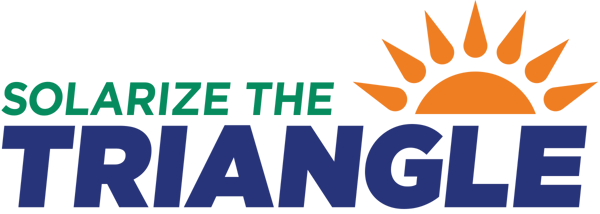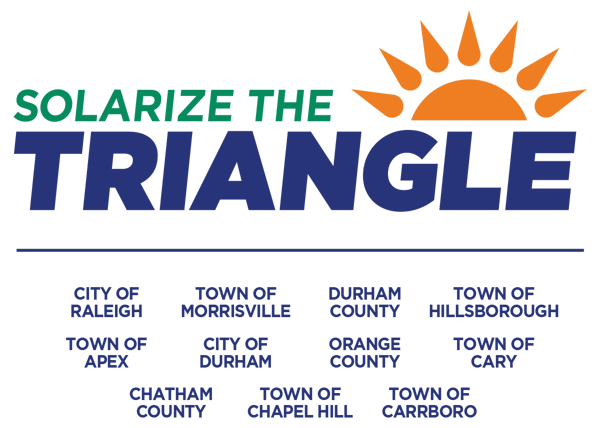
REQUEST FOR PROPOSAL
Published: June 16, 2022
Bids Due: July 15, 2022 by 5pm EST
Solarize the Triangle invites proposals from contractors specializing in the design and installation of residential and commercial solar photovoltaic and battery storage systems to participate in a Solarize campaign for Chatham County, City of Raleigh, Durham County, City of Durham, Town of Cary, Town of Chapel Hill, Town of Hillsborough, Town of Carrboro, Town of Apex, Town of Morrisville, and Orange County.
PRE-BID MEETING
Pre-Bid Meeting: Organizers of the campaign will hold a virtual pre-bid meeting via Zoom on June 28, 2022 at 10:30 AM EST. Prospective bidders are encouraged to attend this meeting to get an overview of the campaign and participate in a Q&A session. Registration is required to receive a link to the virtual meeting.
PROGRAM OVERVIEW
Solarize the Triangle is a public-private coalition consisting of the Triangle J Council of Governments, Solar Crowdsource and participating communities of Chatham County, City of Raleigh, Durham County, City of Durham, Town of Cary, Town of Chapel Hill, Town of Hillsborough, Town of Carrboro, Town of Apex, Town of Morrisville, and Orange County. The objectives of the Solarize the Triangle program are to:
- Making solar energy more affordable: lower the cost of solar energy through the power of group-purchasing and reduced acquisition costs. Pass savings on to residents of the Triangle region;
- Making solar energy more accessible: predetermined, highly-vetted materials, pricing, and contractor(s) through a competitive bid process;
- Education and community engagement: widespread community engagement, education and outreach activities through town hall meetings, workshops, solar “open house” gatherings, and outreach through local community groups and events;
- Promoting solar-positive policies: encourage local governments to adopt streamlined solar energy permitting policies and fair utility distributed generation policies. Advance greenhouse gas reduction goals, clean-energy production, workforce development opportunities, and other community policy objectives; and
- Giving back: A portion of campaign proceeds will be used to donate a solar energy system to a deserving local nonprofit organization and/or help to underwrite solar-energy systems for qualified low- and moderate-Income families with high energy burdens.
REQUEST FOR PROPOSAL DOCUMENTS
Please see Amendment to RFP below
(June 23, 2022 @ 1:30 PM EST)
Contact Solarize the Triangle
Contact Solarize the Triangle at the email address below only for any questions about this RFP (do not contact members of partner communities). All questions and answers will be posted below.
admin@solarizethetriangle.com
Amendment to RFP
(June 23, 2022 @ 1:30 PM EST):
Due to possible future use of federal grant funds to help buy down the cost of solar for qualified LMI participants, a preference for local solar contractors is no longer part of the Selection Criteria. The Selection Criteria and accompanying scoring has changed as follows:
|
Subject |
Description |
Top Score Possible |
|
System Quality |
Evaluates the quality and performance of the proposed equipment including panels, inverters, racking systems, and batteries. Panels should be Tier 1 according to Bloomberg New Energy Finance Corporation, have efficiencies greater than 17% and be rated for wind loads up to 150 mph. |
20 |
|
Pricing |
Assesses the proposed tier prices for base turn-key solar PV systems provided by the respondent and ranks them competitively. Project “Adders” should be reasonably priced when compared with market rates. Additional consideration will be given to the extent bulk-purchasing of “adder” materials such as battery storage and EVSEs are provided. Respondents are encouraged to show a tiered-pricing, bulk-purchasing schedule for adder materials in Attachment D where possible. |
20 |
|
Contractor and Customer Service Experience, Implementation Plan |
Evaluates the respondent based upon their # of years in business, the quality and experience of the proposed project team, the # and size of projects previously completed. Assesses the respondent’s proposed plan for tracking leads, handling project volume, customer service, proposed timeline from site evaluation to contract to installation, and their ability to handle projects within HOAs and historic districts. |
20 |
|
System and Workmanship Warranty |
Evaluates the equipment warranty of the proposed panels and inverters along with the proposed workmanship warranty provided by the Contractor. Panels require a 25-year power warranty with 80% of nameplate power by year 25. Inverters require a warranty of at least 15 years for microinverters and 10-year for string inverters, however longer inverter warranty periods will be viewed favorably. The contractor workmanship warranty is required to be at least one year, however longer workmanship warranty periods will be viewed favorably. |
15 |
|
System Aesthetics |
Evaluates the degree to whi0ch selected components and installations are aesthetically pleasing and blend in with structure and adjacent surroundings. |
2.5 |
|
Financing |
Assesses Contractor’s ability to offer financing options to program Participants including innovative financing options for the low-income community. |
5 |
|
Innovative Concepts |
Assesses the level of innovation the respondent proposes as a part of the core project and as additional items of value for customers to consider. Innovative ideas may be associated with creative use of outdoor spaces, energy efficiency solutions, solutions for low-income communities, early-bird bonus for early signups, equipment upgrades, incentives for early adopters, support for the community project, and models for financing or leasing equipment to low-income communities as a part of the project. |
5 |
|
Community Project |
Evaluate the ingenuity, level of commitment (i.e., monetary contribution), and services the respondent proposes for a project to support the nonprofit community. |
5 |
|
Marketing Plan |
Assesses the respondent’s ability to support education and marketing efforts associated with the project. This should be evaluated on the quality of the promotional materials and the level of support offered for the educational and promotional portions of this project. |
2.5
|
Questions and Answers
Question: I understand the request for aggregate pricing, but in past Solarize programs we have further categorized to allow for price per watt by system size (4-6kW at 3.00 per watt, 6.1 kW – 8.5 kW at 2.75/watt, etc.) These are only examples, not true pricing or system size categories, but if I am understanding the RFP, we would use the same price per watt for any sized system based only on tiers of aggregated contracts. This runs the risk of underpricing smaller systems and being uncompetitive on larger sized (10kW for example) systems. Should the cost per watt be the lowest base possible with adders for smaller systems? Please let me know if I am misunderstanding the RFP.
Answer: Your interpretation of the RFP is correct. We are asking for a price per watt regardless of system size. We have found that while the margin on smaller sized systems is less than the margin for larger sized systems, the simplicity of the pricing model helps "sell" the program and it all averages out in the end.
Now, that said, if you would like to include "adders" for smaller sized systems and "discounts" for larger sized systems you are more than welcome to do so. Please include any system-size related adders or discounts in Attachment D of the RFP. This way we can maintain a simple message when talking generally about the pricing and then your firm can get into more detail when making a proposal.
If it helps, the average size residential system in our campaigns in jurisdictions with net metering is 7.5-8.0 kW.
Question: For references, I am assuming you want contact information? Emails?
Answer: Yes, for references, please provide name, phone number and email address.

